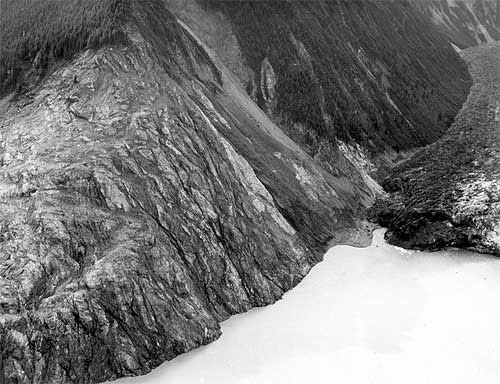
Officials to Test Tsunami Warning System in Alaska
March 16, 2017
The emergency test will be broadcast on NOAA Weather Radio All Hazards, as well as local television and radio stations along the southern coast of Alaska. Residents in some communities may hear warning sirens. Some television systems are programmed to scroll a standard emergency alert text message and, in some cases, the message may not contain the word “TEST.” An audio message will state that the message is only a test, but if the audio is unheard, viewers may not realize the message is only a test.
Southeast Alaska Earthquake. Scar at the head of Lituya Bay and wave damage on the north shore, from southwest of Gilbert Inlet to La Chaussee spit. August 9, 1958. Photos Form a panorama To avoid confusion with an actual alert the test will be canceled if there is excessive seismic activity within 24 hours prior to the test. The test is part of Tsunami Preparedness Week, March 26 to April 1. The test is conducted annually during the same week as the Great Alaska Earthquake and Tsunami of 1964, which killed over 130 people in Alaska, Oregon, and California. Officials promote tsunami safety and awareness and urge coastal residents and visitors to prepare themselves and their families for a tsunami. Tsunami.gov offers complete information, including the current status of tsunami warnings, advisories and watches. A list of frequently asked tsunami questions and answers as well as tsunami safety rules and other educational materials can be found on the site as well. Alaska is the most seismically active state in the United States, and has experienced 12 of the 15 largest earthquakes in United States’ history, and disaster preparedness is Alaska's greatest tool for protecting Alaska's people, property, and livelihoods. The 1946 Aleutian Tsunami killed 159 people in Hawaii, five in Alaska, and one in California, and sent a 100 foot tsunami into Scotch Cap on Unimak Island destroying a U.S. Coast Guard lighthouse. The world’s highest tsunami was in Glacier Bay National Park’s Lituya Bay in 1958, when a magnitude 8.2 earthquake generated a rockslide that sent water surging to 1720 feet and killed two boaters. Test organizers are asking coastal Alaskans to provide feedback after the test at ready.alaska.gov.
Related Articles:
On the Web:
Editing by Mary Kauffman, SitNews
Source of News:
Representations of fact and opinions in comments posted are solely those of the individual posters and do not represent the opinions of Sitnews.
|
||
